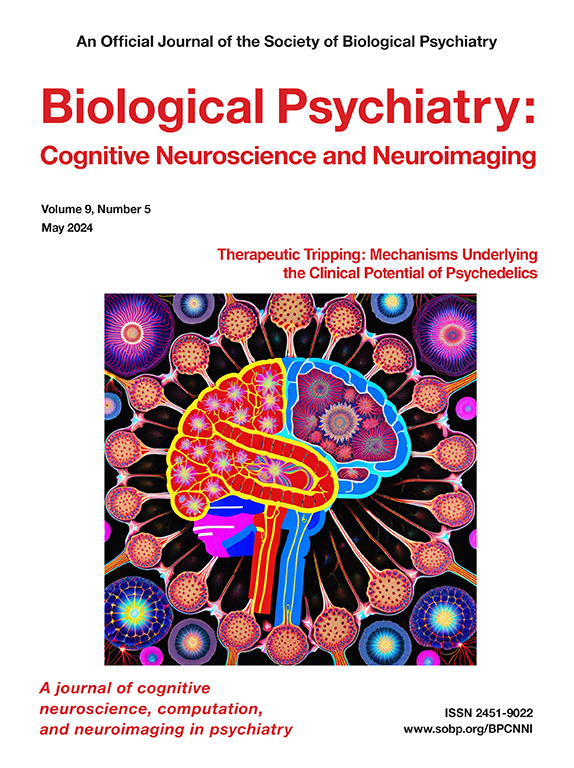复发性抑郁症缓解患者缰核异常的厌恶学习信号。
IF 4.8
2区 医学
Q1 NEUROSCIENCES
Biological Psychiatry-Cognitive Neuroscience and Neuroimaging
Pub Date : 2025-09-01
DOI:10.1016/j.bpsc.2025.04.006
引用次数: 0
摘要
背景:对惩罚的超敏反应是重度抑郁症的核心特征之一。对惩罚的过度敏感被认为源于异常的厌恶学习。在厌恶学习的关键区域之一是缰。尽管抑郁症患者厌恶学习功能障碍的证据已经得到证实,但在抑郁症症状缓解期间,这种功能障碍及其神经相关因素是否持续存在,在很大程度上仍未得到探索。方法:对36例复发性重度抑郁症(MDD)无药缓解患者和27例健康对照者参与巴甫洛夫经典条件反射任务的功能性MRI数据进行计算模型框架评估,以评估厌恶学习期间缰核的时间差异相关激活。此外,进行了广义的心理生理相互作用分析,以评估颞差信号与缰核作为先验感兴趣的区域的功能连通性。结果:与健康对照相比,患者双侧缰带中与时间差异相关的厌恶学习激活显著增加。这种激活与MDD缓解组的残留症状相关。此外,与对照组相比,患者缰和腹侧被盖区之间的功能连通性下降。结论:在MDD缓解患者中,在厌恶学习期间,特别是在预期惩罚期间,缰状核活动增加,同时缰状核-腹侧被盖区功能连通性下降,反映了对厌恶环境线索和惩罚的影响过度敏感和/或无法调节。试验注册:NTR3768。本文章由计算机程序翻译,如有差异,请以英文原文为准。
Aberrant Aversive Learning Signals in the Habenula in Remitted Patients With Recurrent Depression
Background
Hypersensitivity to punishment is one of the core features of major depressive disorder (MDD). Hypersensitivity to punishment has been proposed to originate from aberrant aversive learning. One of the key areas in aversive learning is the habenula. Although evidence for dysfunctional aversive learning in patients with depression is well established, whether this dysfunction and its neural correlates persist during symptomatic remission of depression remains largely unexplored.
Methods
Functional magnetic resonance imaging data from 36 medication-free remitted patients with recurrent MDD and 27 healthy control participants participating in a Pavlovian classical conditioning task were assessed within a computational modeling framework to evaluate temporal difference–related activation of the habenula during aversive learning. Furthermore, generalized psychophysiological interaction analyses were performed to assess functional connectivity of the temporal difference signal with the habenula as an a priori region of interest.
Results
Relative to healthy control participants, patients showed significantly increased temporal difference–related aversive learning activation in the bilateral habenula. This activation was correlated with residual symptoms in the remitted MDD group. Furthermore, patients exhibited decreased functional connectivity between the habenula and the ventral tegmental area compared with control participants.
Conclusions
The increased habenula activity during aversive learning, particularly during the expectation of punishment, together with decreased functional habenula–ventral tegmental area connectivity in remitted patients with MDD, reflect hypersensitivity to and/or inability to regulate the impact of aversive environmental cues and punishment.
求助全文
通过发布文献求助,成功后即可免费获取论文全文。
去求助
来源期刊

Biological Psychiatry-Cognitive Neuroscience and Neuroimaging
Neuroscience-Biological Psychiatry
CiteScore
10.40
自引率
1.70%
发文量
247
审稿时长
30 days
期刊介绍:
Biological Psychiatry: Cognitive Neuroscience and Neuroimaging is an official journal of the Society for Biological Psychiatry, whose purpose is to promote excellence in scientific research and education in fields that investigate the nature, causes, mechanisms, and treatments of disorders of thought, emotion, or behavior. In accord with this mission, this peer-reviewed, rapid-publication, international journal focuses on studies using the tools and constructs of cognitive neuroscience, including the full range of non-invasive neuroimaging and human extra- and intracranial physiological recording methodologies. It publishes both basic and clinical studies, including those that incorporate genetic data, pharmacological challenges, and computational modeling approaches. The journal publishes novel results of original research which represent an important new lead or significant impact on the field. Reviews and commentaries that focus on topics of current research and interest are also encouraged.
 求助内容:
求助内容: 应助结果提醒方式:
应助结果提醒方式:


